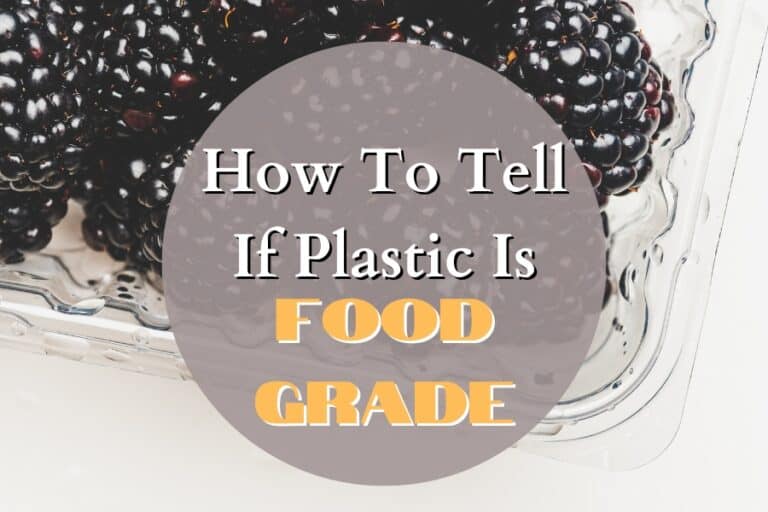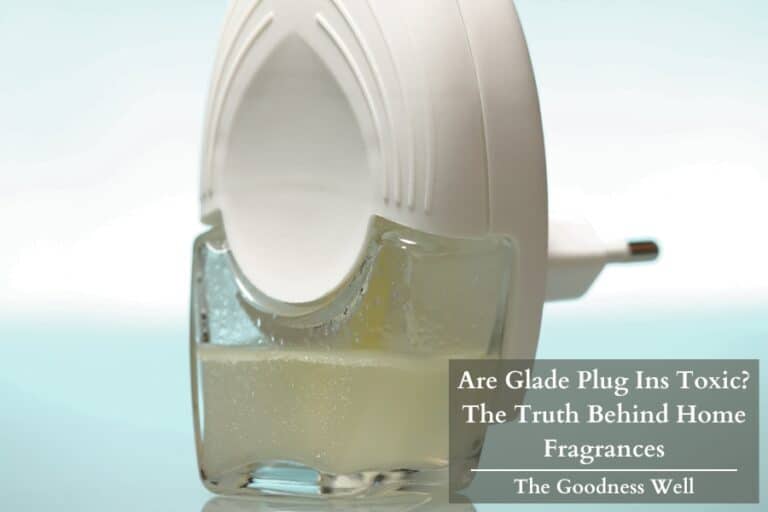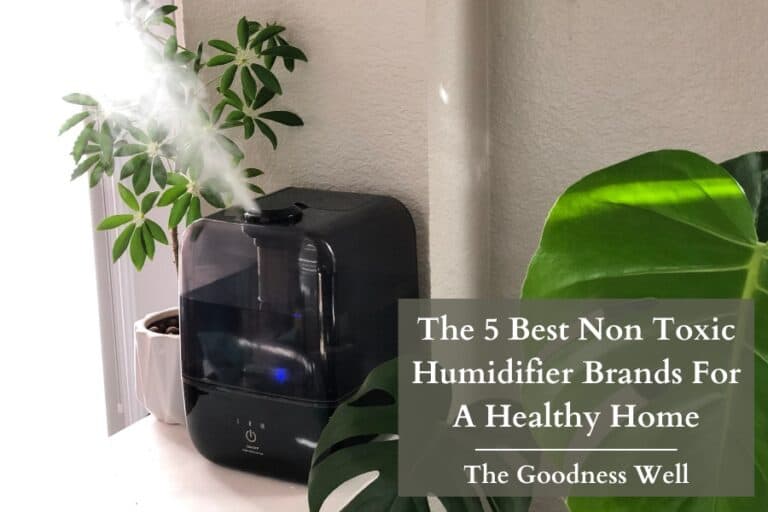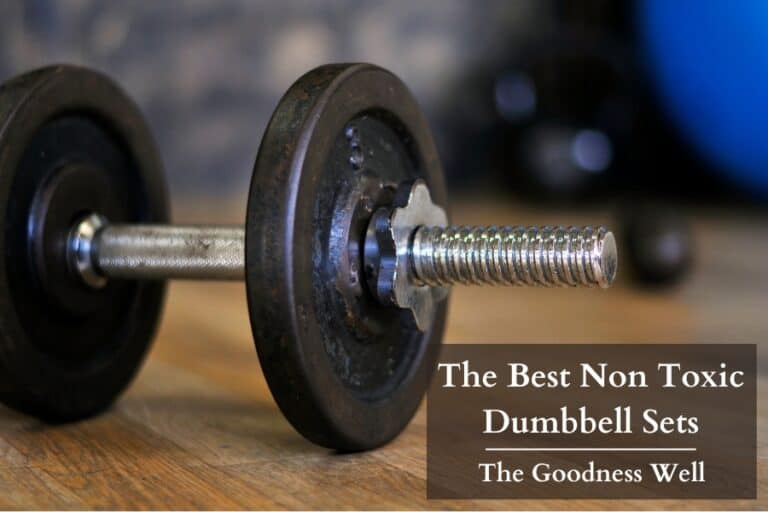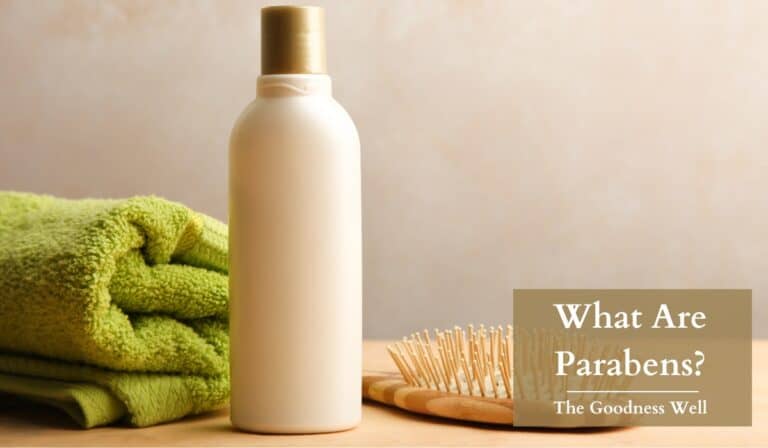Is West Elm Furniture Non Toxic? or Not?
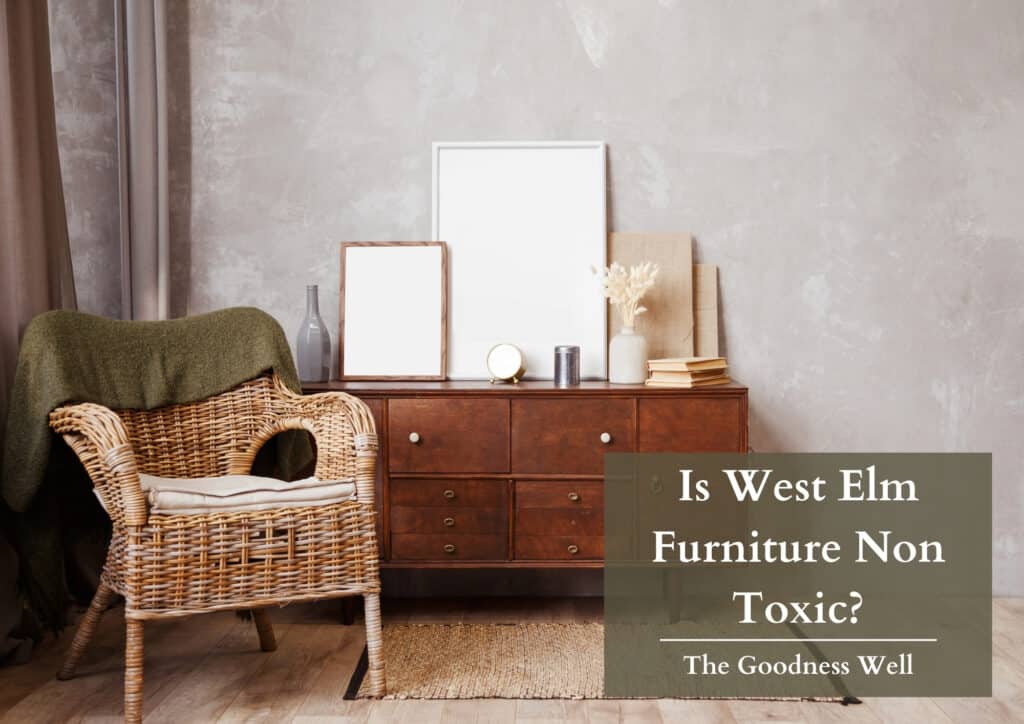
Our purchases can impact both our health and the environment, and yes that means our furniture choices too.
But which brands can you trust to share your concerns and make safe, non toxic furniture?
We asked ourselves the same questions, and to be sure of the answers we did our own research.
In this article, we’ll cover one of the most well-known furniture brands, West Elm, and answer, “Is West Elm Furniture Non Toxic?“
Let’s get into what we found. 🔎
TL;DR
West Elm is not a non toxic brand. Most of West Elm’s furniture is made up of synthetic materials(like polyester and polyurethane foam) and chemical paint, treatments, and stains containing VOCs(Volatile Organic Compounds). Chemicals like VOCs and phthalates found in synthetic materials, dyes, or engineered wood are linked to health issues from skin irritation to endocrine disruption and cancer.
With that being said West Elm does produce some furniture with non toxic certification and without synthetic materials. However, we don’t consider West Elm a non toxic brand because most of the furniture they make is still toxic for consumers. To really be a non toxic brand we expect safe furniture standards in every product.
Understanding What Makes Furniture Toxic 💭
So to start let’s get into what makes furniture toxic…
From start to finish furniture products are exposed to a wide variety of chemicals.
Below are the materials used in West Elm furniture and why they are considered toxic.
Wood(Engineered Wood)
The presence of chemicals like VOCs (Volatile Organic Compounds) in wood comes from the use of preservatives, stains, and varnishes during its harvesting, processing, or treatment.
VOCs are a large group of chemicals that are known to be harmful to humans because they have the ability to emit gasses.
Some of the most harmful VOCs you may have heard of are formaldehyde, benzene, and toluene.
These chemicals are linked to very serious health risks including damage to the liver, kidney, or central nervous system and cancer!
Fabrics
Synthetic fabrics and things added to fabrics like dyes, stain or water-resistant sprays, or fire retardancy can introduce harmful chemicals like phthalates, formaldehyde, Polyvinyl chloride (PVC), Perfluorinated Chemicals (PFCs)in stain and water-resistant coatings, Azo Dyes, Ammonia, and Chlorinated Tris.
All of these chemicals are linked to serious health effects. For example, phthalates are linked to a variety of health challenges linked to reproductive and developmental disorders.
The tanning process of leather involves chemicals like chromium, which is toxic and can cause skin irritation and allergic reactions. High levels of exposure to chromium can lead to respiratory problems, kidney and liver damage, and an increased risk of lung cancer.
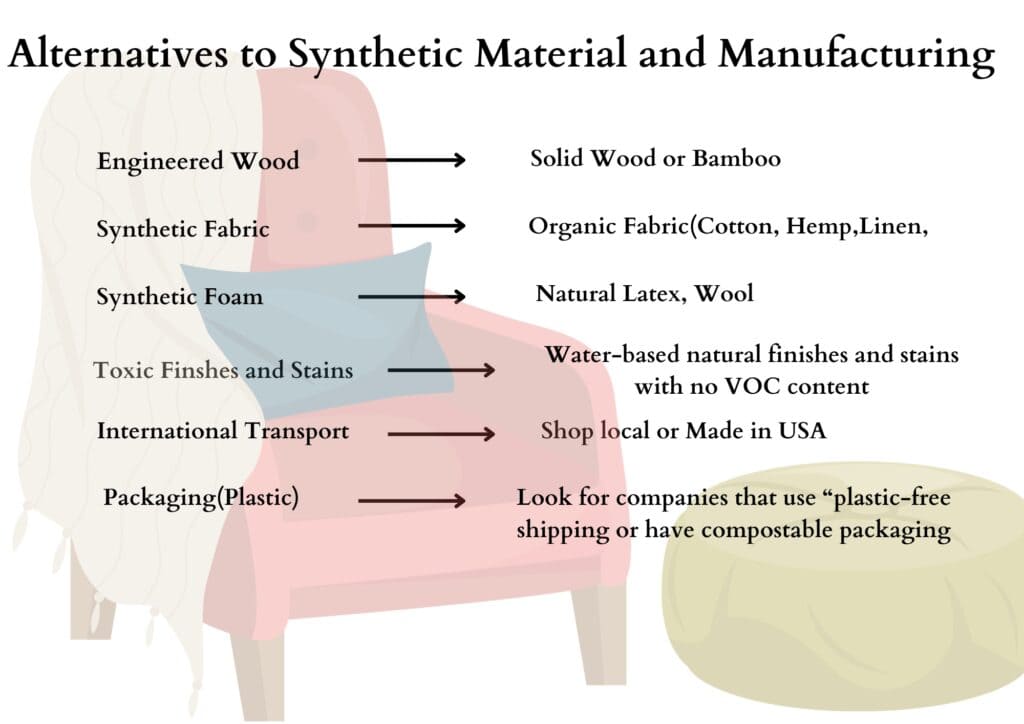
Synthetic Foam
The production of foam specifically synthetic foam like polyurethane foam can release VOCs. Isocyanates are a key ingredient in polyfoam that can irritate the mucous membranes of the eyes and gastrointestinal and respiratory tracts.
Diisocyanates, a type of isocyanate, are known for their effect on asthma and other lung problems.
Finishes
Adhesives, paints, or varnishes used in finishing the couch often contain chemicals. Some of these chemicals may include BPA(BPS, BPF), heavy metals, VOCs, phthalates, and formaldehyde.
Packaging
While not directly part of the couch, some packaging materials can off-gas harmful substances. This includes any microplastics released from plastic packaging.
Transport
Some companies who use the cheapest and often time the most environmentally toxic way of transport can introduce chemicals into the environment. This is seen in companies that import a lot of their materials or products. It’s best to buy from companies who use sustainable ways to transport goods and who are local or close to you so that it cuts down on shipping distances.
So we’ve talked about the materials that make furniture toxic now let’s take a look at the materials used in West Elm furniture.

Toxic examples From West Elm Furniture
West Elm is not a non toxic brand because although they do offer a line of non toxic furniture. The majority of their furniture lacks third-party certifications and contains synthetic materials and chemicals known to be harmful to humans.
Let’s look at two examples of popular West Elm furniture and the details that make them toxic.
Example # 1
First up, we have the Laurent 3- Piece Bumper Chaise Sectional,
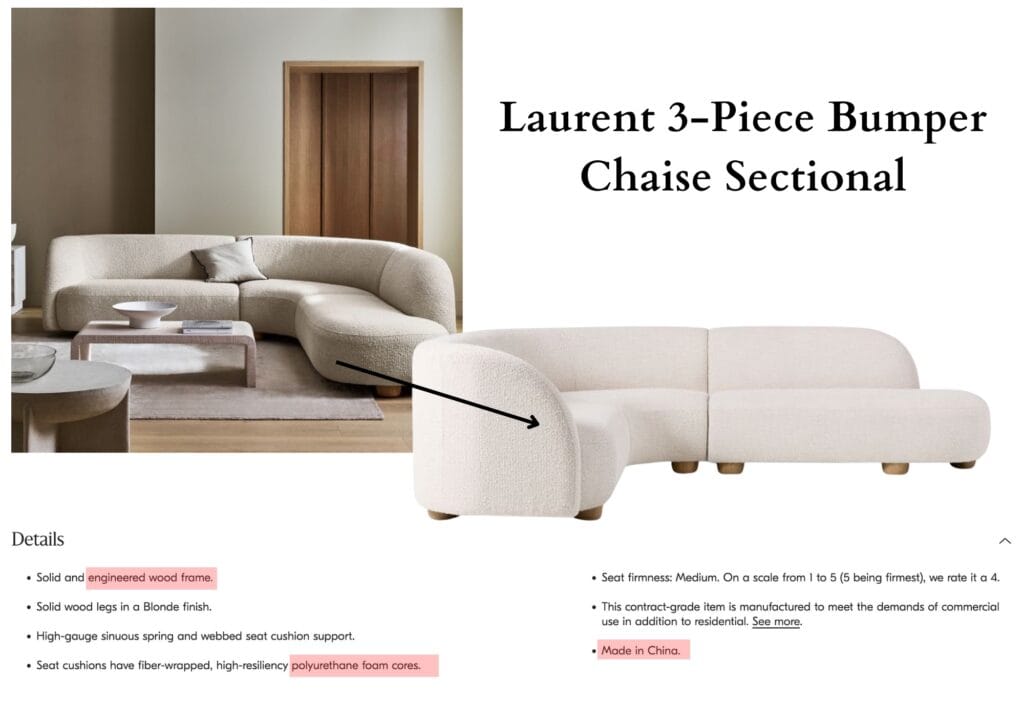
Now don’t get me wrong this sectional is super cute! But also super synthetic!
Looking at some of the details we highlighted you can see there’s engineered wood for the frame, polyurethane foam, and lastly made in and shipped from China.
The problem we have with these three things is that engineered wood(aka synthetic man-made wood) could be plywood, MDF, or particle board, you run into several problems. These woods are glued together using adhesives that contain formaldehyde, a known carcinogen.
Polyols, derived from petroleum products, and diisocyanates, such as Toluene Diisocyanate (TDI) and Methylene Diphenyl Diisocyanate (MDI), are combined to create the synthetic material known as polyurethane foam. Polyurethane foam contains toxic chemicals like VOCs, Isocyanates, colorants, stabilizers, and antimicrobial agents.
| VOCs | Linked to skin irritation, asthma, respiratory challenges, and some(not all) VOCs are linked to cancer |
| Isocyanates | Linked to irritation to the skin, asthma, and respiratory system issues |
| Colorants | Can cause skin irritation, allergic reactions, and in cases of prolonged exposure to carcinogenic compounds, an increased risk of cancer. |
| Stabilizers | Include phthalates which have been linked to endocrine disruption, immune and nervous system disorders, reproductive issues, and developmental problems in children |
| Antimicrobial Agents | Can disrupt thyroid function and hormone regulation |
Lastly, this sectional is made in China. This can mean a lot of things as far as labor ethics…but we won’t get into that. This implies that West Elm furniture undergoes long-distance transportation, creating significant environmental costs.
You can also see there are absolutely no third-party certifications that back non toxic standards for this furniture. Which means no VOCs emission limits and no sustainable furniture assurances. 👎🏽
Example # 2
Next up, we have West Elm’s Leroy Chair.
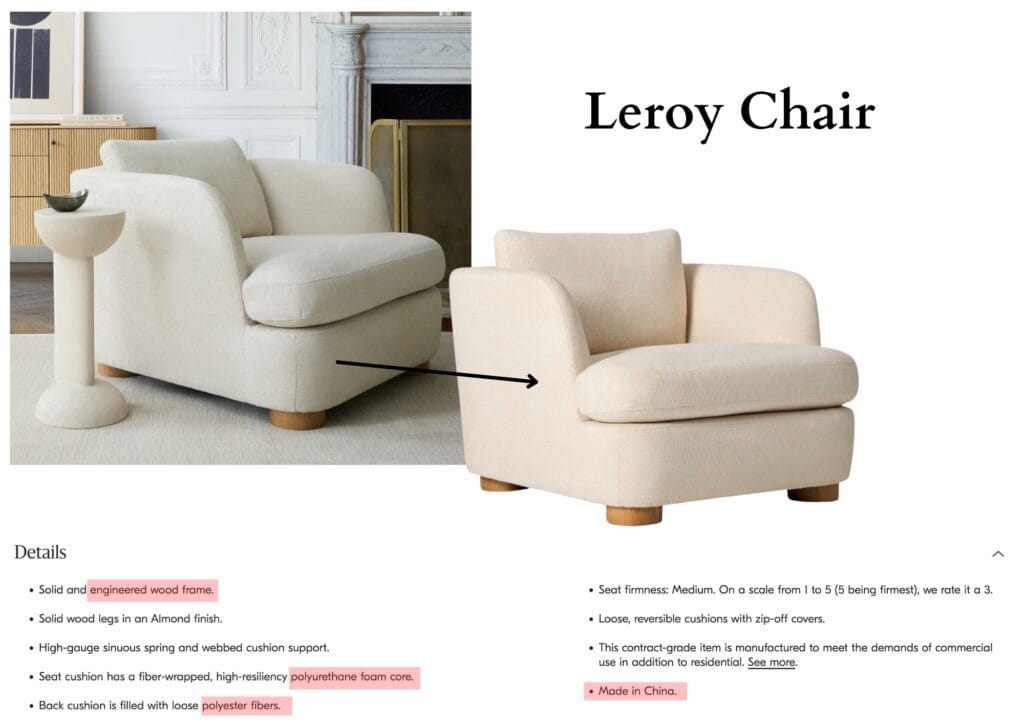
Again you can see synthetic materials are being used. Then engineered wood, polyurethane foam, and polyester fibers.
Polyester fibers are synthetic fibers made from crude oil (aka petroleum). Polyester can release microplastics into the environment and can off-gas VOCs leading to respiratory and skin irritation.
And again there are no independent third-party certifications present👎🏽
Are All West Elm Products Toxic?
Nope!
Some of their furniture holds certifications from the Forest Stewardship Council (FSC) and GREENGUARD GOLD, indicating it’s non-toxic.
Again we still do not consider West Elm a non toxic brand because overall most of their furniture contains toxic synthetic materials(polyester, polyfoam, engineered wood) and toxic chemicals (VOCs, phthalates, formaldehyde).
Personally, I would buy from a company that puts consumer safety and environmental health first in not just some of their products but ALL of them.
Buuuuuut… if you are still considering buying furniture from West Elm look for ones certified by GREENGUARD Gold and use sustainable and non toxic materials like FSC Certified solid wood.
While West Elm is making strides towards making more non toxic furniture, they’re just not fully there yet.
Always check the details for materials and certifications of each product before buying and never settle for toxic furniture.
Frequently Asked Questions
No, although West Elm uses highly synthetic and processed materials, the company has strayed away from any use of flame retardants.
A lot of major furniture brands use toxic materials and chemicals. Some of these include IKEA, Ashley Furniture, and Article Furniture. If you’d like to know more about Article furniture check out our in depth review of Article furniture and what makes it toxic.
The GREENGUARD Gold Certification means that a product has been tested and meets very strict standards for low chemical emissions, specifically VOCs. This certification is super important when considering your indoor air quality and potential pollutants.

